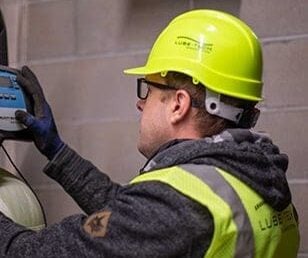Every manufacturing professional understands the importance of safety. Accidents not only cause injury, but also disrupt production, damage morale and can incur significant costs.
The Lube-Tech safety team wants everyone to work safely. In this blog, we’ll explore a range of ideas to cultivate a safety-first environment on your manufacturing floor.
1. Invest in a Culture of Safety:

Safety goes beyond rules and regulations; it’s about fostering a shared commitment to well-being. Here’s how to build that culture:
Leadership involvement: Lead by example. Regularly walk the shop floor, address safety concerns, and emphasize the importance of safe work practices.
Open communication: Encourage open communication about safety hazards. Workers should feel empowered to report issues without fear of reprisal.
Employee engagement: Involve employees in safety discussions and committees. This fosters a sense of ownership and builds trust.
2. Prioritize Training and Awareness:
A well-trained workforce is a safe workforce. Here are some training essentials:
Comprehensive safety programs: Develop programs that cover hazard identification, safe work procedures for specific tasks, and emergency protocols.
Regular training sessions: Conduct regular refresher courses to keep safety protocols top-of-mind.
New hire onboarding: Integrate safety training into onboarding processes for new employees.
3. Mitigate Hazards Through Proactive Measures:
Hazard identification and risk assessment: Regularly conduct safety audits to identify potential hazards and assess their risks.
Machine guarding: Ensure all machinery has proper guards and safety interlocks in place (when necessary).
Personal protective equipment (PPE): Provide appropriate PPE for all tasks and ensure proper use and maintenance.
Housekeeping: Maintain a clean and organized work environment to minimize slips, trips, and falls.
Ergonomics: Design workstations and tasks to promote proper posture and prevent musculoskeletal disorders.
Consistent maintenance: Make sure to keep your machines and the fluids in them clean, up-to-date and well maintained. Things like fluid analysis, preventive maintenance and regular industrial cleaning can go a long way to keeping your manufacturing floor safe.
4. Leverage Technology for Continuous Improvement:
Safety management software: Utilize software to track incidents, manage safety data, and identify trends.
Automation: Explore automation for repetitive or high-risk tasks to minimize human error.
Visual communication: Utilize clear signage, floor markings, and safety posters to communicate safety protocols effectively.
5. Recognition and Positive Reinforcement:
Positive reinforcement: Recognize and reward employees who consistently demonstrate safe work practices.
Safety incentive programs: Consider implementing incentive programs to motivate safe behavior.
Remember, safety is an ongoing process. By consistently implementing these tips and fostering a culture of safety, manufacturing professionals can create a secure work environment where everyone thrives.
